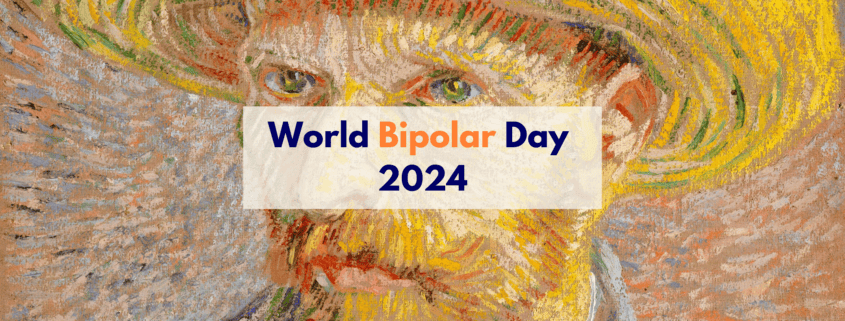
World Bipolar Day 2024
At least 46 million people worldwide have bipolar disorder. Bipolar Disorder is a mental health condition characterized by extreme mood swings, including depressive episodes and manic episodes. This disorder affects millions of people worldwide, but it can be challenging to diagnose and treat.
Living with Bipolar disorder can cause significant disruptions in a person’s life, affecting their relationships, work, and overall well-being. However, with proper treatment, many people with bipolar disorder can manage their symptoms and lead fulfilling lives.
World Bipolar Day is observed every year on Vincent Van Gogh’s birthday, March 30th , to raise awareness about bipolar disorder. World Bipolar Day aims to promote acceptance, understanding, and support for those who are affected by it. Each year on this day, we unite to recognize, learn, and bring world awareness to how bipolar disorder affects many people.
One of the main objectives of World Bipolar Day is to reduce the social stigma often associated with the disorder. People struggling with mental illness often face discrimination and misunderstanding from others, which can make it challenging to seek treatment and support. World Bipolar Day aims to break down these barriers and encourage more people to seek the help they need.
Keep reading to help us in raising awareness about bipolar disorders.
What Is Bipolar Disorder?
Bipolar disorder, also known as manic-depressive disorder, is a mental health disorder that can lead to depression, mood swings, and general mood changes. While many people have heard of bipolar disorder, it is still commonly misunderstood.
During the high, or mania, period, people tend to feel euphoric and energized. During the low or depression period, people may experience feelings of extreme sadness or hopelessness.
History
Bipolar conditions have been observed for centuries. Historians believe it was first documented in the medical literature of Hippocrates. Even during ancient times, it was recognized that people could experience extreme highs and lows in their emotions. Hippocrates described two distinct states: mania and depression.
These are still seen today as the major bipolar disorder signs medical professionals look for to form a diagnosis. Another ancient Greek from the 1st century, Aretaeus of Cappadocia, confirmed these findings. However, it wasn’t until the 19th century that a conceptual understanding of bipolar disorder emerged.
In the 1850s, French neurologist Jules Baillarger and psychiatrist Jean-Pierre Falret presented their findings on the condition. They coined terms such as “folie à double forme” (dual-form insanity) and “folie circulaire” (circular insanity).
Over 100 years later, in 1999, the International Bipolar Foundation (IBPF) was founded. They are the driving force behind a lot of modern research into bipolar disorder symptoms and treatment.
History of World Bipolar Day
We celebrate World Bipolar Day on March 30th because it is the birthday of one of the most influential artists of all time, Vincent van Gogh. Van Gogh’s life was characterized by a close parallel between his creative genius and psychological struggles. These were posthumously diagnosed as bipolar disorder.
This day recognizes the contributions and efforts of those with bipolar disorder, their families, and friends. It is also a day for increasing awareness about this condition. The aim is to spread awareness and reduce the stigma associated with mental health issues.
Through educational resources, outreach programs, and other initiatives, World Bipolar Day supports those affected by bipolar disorder. We hope to help them lead full and productive lives while controlling their symptoms.
Bipolar Disorder Symptoms
Part of celebrating World Bipolar Day is education. Education about mental health disorders often starts by recognizing certain conditions’ signs. What are some common symptoms of bipolar disorder?
First, it’s helpful to understand that there are different types of bipolar disorder that present with different symptoms. However, some common signs of bipolar disorder may include the following:
- Intense feelings of euphoria or happiness (known as mania) followed by bouts of depression
- Rapidly changing moods that can last for days or weeks at a time
- Loss of interest in activities that were once enjoyable
- Difficulty concentrating
- Difficulty making decisions
- Impulsive and reckless behavior (risky spending, promiscuity, and drug or alcohol abuse)
- Feelings of worthlessness or guilt
- Insomnia
- Excessive sleeping
- Unexplained physical problems (headaches and stomachaches)
Bipolar Disorder Treatment
Treatment for bipolar disorder can vary depending on individual needs. The primary goal is to manage symptoms and reduce their severity. Common treatment options for bipolar disorder include:
- Medications
- Psychotherapy
- Lifestyle changes
- Social support networks
- Complementary therapies
TMS treatment may also be a viable option. TMS is short for Transcranial Magnetic Stimulation therapy. TMS therapy involves using a magnet to stimulate the brain. During TMS therapy, electromagnetic pulses create a magnetic field that can penetrate the skull. This allows it to target specific brain areas. The process is non-invasive and outpatient. Studies have shown that TMS can reduce depression, mania, and other symptoms associated with bipolar disorder.
Get Help With Bipolar Disorder
Overall, World Bipolar Day is an important opportunity to raise awareness about bipolar disorder and promote understanding and support for those who are affected by it. By working together, we can reduce the stigma surrounding the disorder and improve the lives of people living with bipolar disorder around the world.
Bipolar disorder doesn’t have to be a barrier to happiness. If you are struggling, talk to your doctor about diagnosis and treatment options.
If you are interested in learning more about TMS therapy, get in touch with us here.
Leave a Reply
Want to join the discussion?Feel free to contribute!